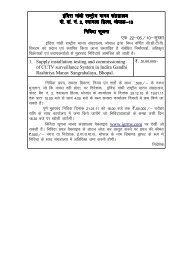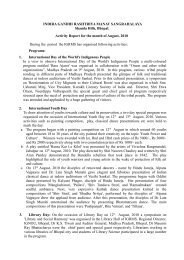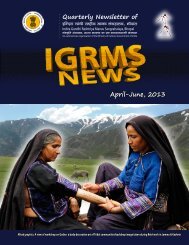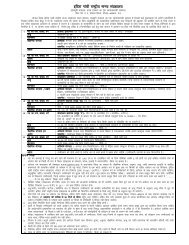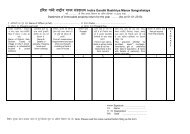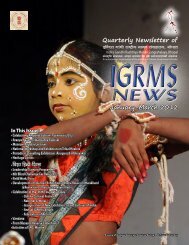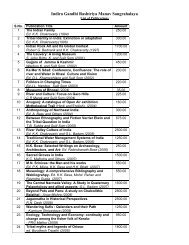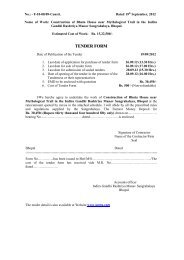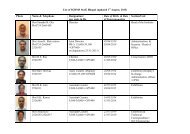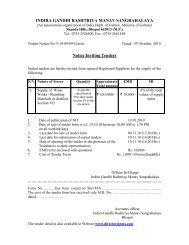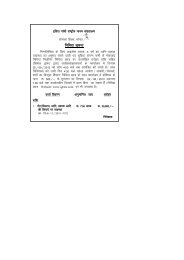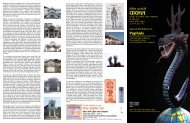Indira Gandhi Rashtriya Manav Sangrahalaya (National ... - IGRMS
Indira Gandhi Rashtriya Manav Sangrahalaya (National ... - IGRMS
Indira Gandhi Rashtriya Manav Sangrahalaya (National ... - IGRMS
You also want an ePaper? Increase the reach of your titles
YUMPU automatically turns print PDFs into web optimized ePapers that Google loves.
<strong>Indira</strong> <strong>Gandhi</strong> <strong>Rashtriya</strong> <strong>Manav</strong> <strong>Sangrahalaya</strong> 279<br />
rituals. As you perhaps know, I started a folk dance festival in the same spirit.<br />
Unfortunately, none of these had been followed up as vigorously as they should<br />
have been. Consequently, we have already lost a good deal. The suggestions you have<br />
made on the last page are good ones. I think, it should be persuaded. The only<br />
difficulty is that this year is one of the great financial stringency when every<br />
programme is being cut to the very bone. However, the setting up a committee of<br />
knowledgeable people will not need immediate finance, and can be considered. These<br />
are my first thoughts. I shall write to you later on this.<br />
(Mrs. <strong>Indira</strong> <strong>Gandhi</strong>)<br />
July 2, 1974<br />
On the advice of the Prime Minister, the Department of Culture, Government<br />
of India, had asked the Anthropological Survey of India (An. S.I) to work on the<br />
project since 1975 onwards and a nucleus Office was started from New Delhi in<br />
March, 1977 for the project. During the same period a preliminary Plan Outline<br />
of the proposed new Museum was published, after a series of meetings by experts.<br />
The Plan-Outline was critical of the biasness of the existing conventional museums<br />
in India. It said that the existing art and archaeological museums in the country<br />
highlighted artistic traditions of India, and didn’t tell the story of evolution of<br />
Indian civilization and about the varieties of cultural life in contemporary India.<br />
The other types of museums dealing with natural history, science and industry<br />
convey basic principles of their subjects, but tell very little of the man who has<br />
created and developed civilizations. Therefore, the idea behind the ‘Museum of<br />
Man’, would be to present an integrated vision of human life, not segmented<br />
pictures determined by artificial disciplinary boundaries.<br />
After a series of searches and deliberations at various levels, it was decided,<br />
in 1978, to set up the ‘<strong>National</strong> Museum of Man’ (NMM) at Bhopal, the central<br />
province of India. A site of about 200 acres offered by the State government of<br />
Madhya Pradesh, at the ‘Shamla hills’, overlooking the main Bhopal lake, was<br />
accepted and some portion of the site was occupied by early 1979. The Foundation<br />
Stone of the new Museum was laid on 21 st April, 1979, by the then Union Minister,<br />
Dr. P.C. Chunder. By March 1985, the organization was renamed as ‘<strong>Rashtriya</strong><br />
<strong>Manav</strong> <strong>Sangrahalaya</strong> (RMS). Again in 1993, it was re-christened as ‘<strong>Indira</strong> <strong>Gandhi</strong><br />
<strong>Rashtriya</strong> <strong>Manav</strong> <strong>Sangrahalaya</strong> (<strong>IGRMS</strong>), considering the seminal contributions<br />
and involvement of the late Prime Minister in developing the Museum.<br />
The museum-site at ‘Shamla hills’, is a very important geographical territory.<br />
It is one of the chains of 31 hills in the Vindhyan range, infested with a large<br />
number rock caves with evidence of pre-historic human settlements. The site<br />
was once on a 30 mile long stretch of water, created by joining the streams of<br />
river Kaliasot and Betwa, a water body which was drained in 30 years, after the<br />
11 th century dam constructed for creating it, was cut, in course of one of the warlike<br />
engagements in the 16 th century. Today Shamla hills is an oasis of heritage<br />
related action and research initiatives. About a dozen cultural centres have come



